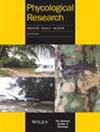珊瑚礁泻湖中受当地环境影响的植被种类
IF 1
4区 生物学
Q2 MARINE & FRESHWATER BIOLOGY
引用次数: 0
摘要
从海岸到海洋,珊瑚礁一般可分为泻湖区、礁峰和前礁。不同区域的环境变量(如营养通量、光照和水温)各不相同,并影响着水下大型植物的生物多样性。此外,环礁湖内植被的生物多样性似乎受到多种极端局部条件的影响。我们研究了小尺度变化对植被多样性的影响,并在日本冲绳县 Bise Point 环礁湖内一个明确界定的区域内进行了生态调查。从 2019 年 10 月到 2021 年 3 月,历时 19 个月,从调查的四分格中共鉴定出 20 种大型藻类(4 种绿藻、6 种褐藻和 10 种红藻)和 4 种海草。物种出现的模式在空间和时间上具有异质性。值得注意的是,各监测点之间的水流和沉积物通量变化很大。通过冗余分析,我们可以评估环境因素对各监测区域植被的影响。本研究考虑了六个环境因素,但它们对当地植被的影响并不相同。冗余分析表明,水深、流速和沉积颗粒的小分率是对当地植被影响最大的三个因素。这项研究为珊瑚礁泻湖植被的决定因素提供了一些重要的启示。我们的研究结果表明,与季节效应相比,我们研究的因素对植被的影响更大。本文章由计算机程序翻译,如有差异,请以英文原文为准。
Vegetation variety affected by local environments in a coral reef lagoon
From shore to sea, coral reefs can generally be divided into a lagoon zone, a reef crest, and a fore reef. Environmental variables, such as nutrient fluxes, light availability, and water temperature, vary among the zones and influence the biodiversity of submerged macrophytes. Additionally, the biodiversity of vegetation within the lagoon appears to be affected by multiple and extremely localized conditions. We investigated the impact of small-scale variations on vegetation diversity, and implemented an ecological survey within a well-defined area inside of a lagoon at Bise Point, Okinawa, Japan. A total of 20 macroalgal species (four green algae, six brown algae, and ten red algae) and four seagrass species were identified from the surveyed quadrats over a period of 19 months, from October 2019 to March 2021. Patterns in species occurrence were spatially and temporally heterogeneous. Notably, water motion and sediment flux were highly variable among the monitoring sites. Redundancy analysis allowed us to evaluate the significance of environmental factors on the vegetation of each monitoring area. Six environmental factors were considered in this study, but their impacts on local vegetation were not equivalent. Redundancy analysis suggested that water depth, flow velocity, and the ratio of the small fraction of deposition particles were the three factors with the strongest influence on local vegetation. This study provides some crucial insights into the determinants of vegetation in a coral reef lagoon. Our findings suggest that the factors we examined exert more influence on the vegetation than seasonal effects.
求助全文
通过发布文献求助,成功后即可免费获取论文全文。
去求助
来源期刊

Phycological Research
生物-海洋与淡水生物学
CiteScore
3.60
自引率
13.30%
发文量
33
审稿时长
>12 weeks
期刊介绍:
Phycological Research is published by the Japanese Society of Phycology and complements the Japanese Journal of Phycology. The Journal publishes international, basic or applied, peer-reviewed research dealing with all aspects of phycology including ecology, taxonomy and phylogeny, evolution, genetics, molecular biology, biochemistry, cell biology, morphology, physiology, new techniques to facilitate the international exchange of results. All articles are peer-reviewed by at least two researchers expert in the filed of the submitted paper. Phycological Research has been credited by the International Association for Plant Taxonomy for the purpose of registration of new non-vascular plant names (including fossils).
 求助内容:
求助内容: 应助结果提醒方式:
应助结果提醒方式:


